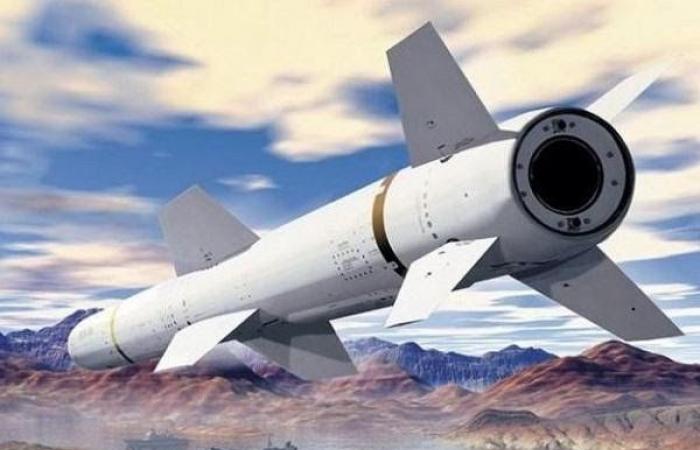Morocco plans to acquire ten “Harpoon Block II (AGM-84L)” anti-ship missiles and SLAM-ER (AGM-84H/K) cruise missiles from Boeing, according to the specialist site military.africa.
“These acquisitions aim to strengthen the capabilities of the Royal Moroccan Air Forces (FRA), particularly with the integration of Harpoon missiles into F-16 Viper combat aircraft. The Royal Armed Forces are expected to receive 24 of these advanced jets by 2026,” the same source said.
It is noted that the A/U/RGM-84 Harpoon is an all-weather, over-the-horizon anti-ship missile system that provides the Navy with a common missile for air and naval launches.

+ Harpoon Block II missiles +
Harpoon’s active radar guidance, warhead design, low-altitude cruise trajectory, and sea-skimming or pop-up maneuvers in terminal mode ensure high survivability and effectiveness. The missile can be launched from surface ships, submarines, coastal batteries or aircraft (without the booster).
Harpoon Block II missiles, equipped with an explosive warhead of 525 kg and a range of up to 280 km, represent the latest generation of anti-ship weapons. Technical reports indicate that these missiles can accurately destroy enemy floating targets and naval assets, including aircraft carriers and landing ships.
To increase the capabilities of its Lockheed Martin F-16 Fighting Falcon combat aircraft in naval warfare, the FRA announced in April 2020 that it was seeking to acquire Boeing AGM-84L Harpoon Block 2 anti-ship missiles from the United States. United in an acquisition project. deal worth $62 million.

+Removal of non-coastal targets +
The US Defense Security Cooperation Agency (DSCA) announced on Tuesday April 14, 2020 that the State Department had approved the sale of 10 Harpoon missiles to Morocco.
The proposed sale includes containers, replacement and repair parts, support and test equipment, publications and technical documentation, personnel training and training materials, U.S. Government technical assistance and representatives of contractors, engineering and logistics support services, and other related elements of logistics support.
The Boeing AGM-84L Harpoon Block II missiles that Morocco has requested to acquire from the United States for its F-16 fighter jets will have reduced coastal targeting capabilities, the United States says. The Harpoon missiles that will be supplied to Morocco are the “non-coastal target suppression” version, which will not be able to attack land targets, according to an April 27, 2022 Federal Register arms sale notification.
One of the Block II AGM-84L Harpoon’s new capabilities is its significantly improved ability to find target ships sailing close to shore or in crowded waters, as well as its ability to use its GPS-assisted navigation to fly accurately before the launch. programmed target coordinates.
“Block II is part of our spiral development plan for Harpoon,” said Jim O’Neill, Boeing general manager for Navy Missile Systems. “Harpoon has proven itself to be a precision strike naval weapon capable of attacking surface ships and land targets from a standoff distance. »
+ Double the amount of smart bombs +
Meanwhile, Morocco will receive BRU-57/A weapons delivery units to double the amount of smart bombs its F-16 fighter jets can carry. L3Harris Technologies announced a $29 million contract in December 2022 to provide intelligent weapons delivery systems to air forces in the Middle East and North Africa.
The BRU-57/A bomb delivery unit will allow F-16 fighter jets to carry two smart weapons on each hardpoint instead of one, doubling munitions capacity. The unit is compatible with 500 and 1000 lb guided weapons.
In addition to anti-ship missiles, Morocco has also acquired medium- and long-range cruise missiles designed for high-precision strikes on land and sea targets. These advanced weapons further strengthen Morocco’s military capabilities.
+ A climb speed of up to 15,240 meters per minute +
The F-16 Fighting Falcon, originally developed by General Dynamics and now manufactured by Lockheed Martin, is a multirole aircraft still in service. Its first flight took place on February 2, 1974 and its official entry into service took place on August 17, 1978. As of April 25, 2019, 4,588 units had been built. The aircraft is powered by a Pratt & Whitney F100-PW-229 turbofan engine, producing 79 kN of thrust without afterburner and 130 kN with afterburner.
The F-16 has compact dimensions with a wingspan of 9.8 meters, a length of 14.8 meters and a height of 4.8 meters, providing a wing area of 27.87 m². Its empty weight is 8,272 kg, while it can reach a maximum weight of 16,900 kg fully loaded. In terms of performance, the F-16 can reach a maximum speed of 2,173 km/h (Mach 2.04) and has an operational ceiling of 15,200 meters.
Its climb speed is impressive, reaching 15,240 meters per minute, and its range is 550 km. The aircraft’s wing loading is 431 kg/m² and its thrust-to-weight ratio is 0.90.
+ The aircraft equipped with a forward-looking infrared radar (FLIR) +
The F-16’s avionics are particularly advanced, including fly-by-wire flight controls, a heads-up display, and a Hands On Throttle-And-Stick (HOTAS) system. Successive versions of the F-16 have seen the integration of increasingly sophisticated radars, from the AN/APG-66 radar to the AN/APG-83 active electronically scanned array (AESA) radar.
The aircraft is also equipped with a forward-looking infrared radar (FLIR), an ALR-56M radar warning receiver, GPS, Link 16 for secure communications and an AN/electronic warfare module. ALQ-131 for jamming and defense missions.
During a recent meeting, the Council approved draft organic laws and decrees aimed at strengthening the military sector, reflecting Morocco’s unwavering commitment to improving its defense capabilities. The high-level discussions, led by the King, underline the strategic importance given to the development of the country’s defense industry.
+ Modernize the armed forces +
This acquisition is part of Morocco’s broader strategy aimed at modernizing its armed forces and asserting control of its maritime domain. Last week, King Mohammed VI chaired a meeting of the Ministerial Council which marked a step towards Morocco’s autonomy as a defense industrialist.
The FRA currently has 23 F-16C/D Block 50/52 aircraft that it received between 2011 and 2012, one of which was damaged over Yemen during combat operations.
Earlier in 2019, the FRA intended to acquire an additional batch of F-16 Fighting Falcons from the United States and modernize its existing fleet. Morocco has requested twenty-five units of the latest Block 72 (F-16V) fighters, worth $3.8 billion.
In response, the US State Department revealed on March 25 that it was considering approving a possible Foreign Military Sale (FMS) to Morocco of 25 F-16C/D Block 72 aircraft and associated equipment for an estimated cost at 3.787 billion dollars, adds Africa Military.
Article19.ma









